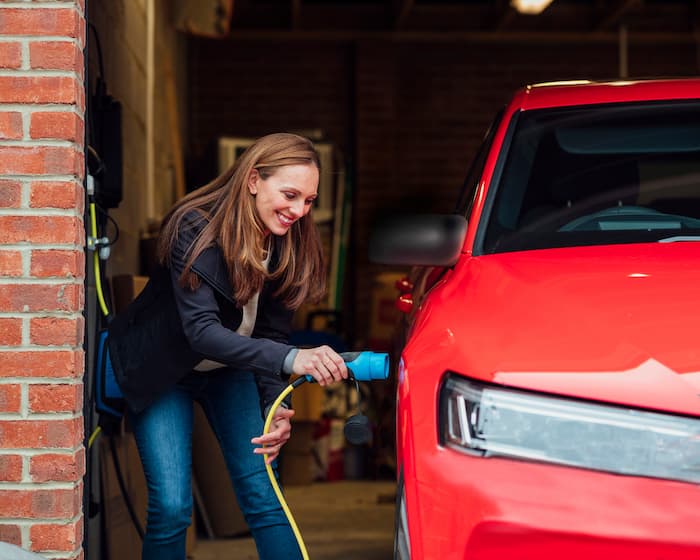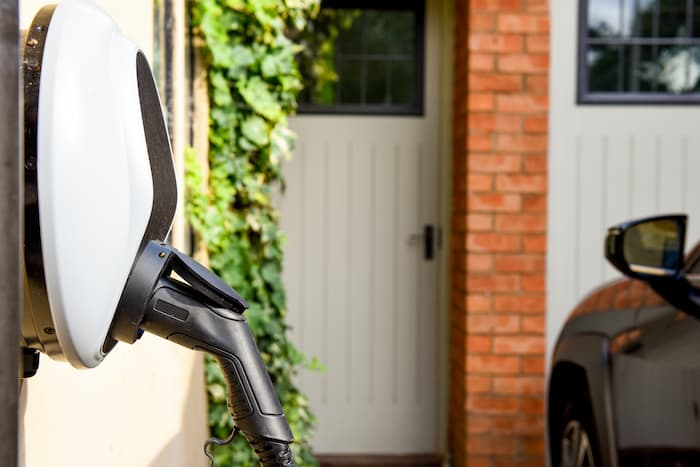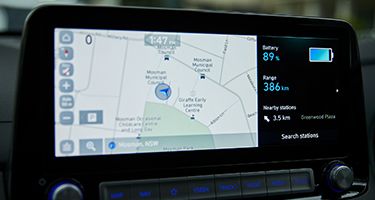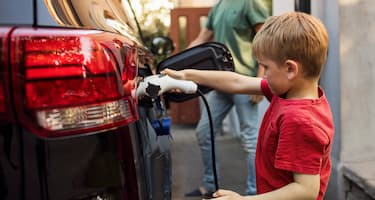With electric vehicle sales increasing year on year in Australia, there are plenty of factors you might want to consider before you purchase one.
Have you thought about how much you’ll spend on an electric car? How much range does your electric car need? Are there any government incentives for electric vehicles in your state or territory?
And while it may seem like an obvious question, have you ever thought about how to charge an electric vehicle?
There is an increasing number of public EV charging stations popping up all over Australia, with many EV owners also choosing to charge their electric cars at home.
To help you understand more about EV charging, here's what we'll cover in the following article:
- Types of Electric Charging Ports
- How to Use an EV Charger
- Can you charge an electric car at home?
- How do I charge my electric car when I'm out and about?
- How long does it take to charge an electric car?
- How much does it cost to charge an electric car?
Types of Electric Charging Ports
There are three types of electric vehicle chargers in Australia. This means you’ll need to carefully identify the type of charger that best suits your electric car (based on your car battery).
These chargers include:
- Level 1 / Mode 2 - Uses an existing power point with a specialised cable supplied with the EV vehicle.
- Level 2 / Mode 3 - A dedicated AC EV charger installed in homes, apartment complexes, workplaces and shopping centres (or anywhere else your car can be parked for a while).
- Level 3 / Mode 4 - A dedicated DC EV charging station used in commercial premises and road-side locations.
And the plugs used at public charging stations across Australia include: [1]
- Type 2 (Mennekes) plug for AC charging (Level 2 / Mode 3 chargers)
- CCS and CHAdeMO for DC charging (Level 3 / Mode 4 chargers)
How to Use an EV Charger
- Plug the charging cable into the charging station.
- Plug the cable into your electric car and listen out for the lock-in sound. Check your indicator lights on the dashboard to ensure your EV battery is charging.
- Once your car is fully charged you can unplug the cable from the electric vehicle and charging station.
Can you charge an electric car at home?
Yes, you can charge an electric vehicle at home. Using an EV charger at home is the most convenient way to charge your electric car overnight.
Standard Power Point
You can charge an electric vehicle using a portable EV charging cable and a standard power point. This type of charger can add 10-20 km of range to your car and can charge for 5-16 hours while you're at home. [1]

Solar EV Charger
The SolarEdge EV Charger is an integrated solar inverter and EV charger that lets you charge your electric car via available solar energy. It is a level 2 charging station with up to 7.4 kW of charging power. This EV Charger is designed for your home and should ideally be in your garage. [2]
Wall Box Charger
A three-phase mounted wall box charger can deliver a maximum AC charge of up to 22kW. This type of charger can add 50-130 km of range to your car and will only charge for 0.5-2 hours. [1]

How do I charge my electric car in public?
As the Australian Government continues to invest in electric vehicle charging infrastructure this may encourage more Australians to adopt charging electric vehicles while on the road.
Tesla Model EV Chargers
Tesla models come with an exclusive plug type and can only be charged in public using Tesla's Supercharger and Destination Charging networks.
While there are fees for most Tesla chargers, the charging rate is determined by the plug-in time. Some supercharger stations also offer on-peak and off-peak rates.
Public EV Charging Stations
While the electric vehicle charging network is expanding across Australia, most states and territories are struggling to keep up with the rapid growth. You can find specific charging locations before a long drive using Plugshare.
Here are all the public charging stations across Australia:
| Regular Charging (AC) | Fast Charging (DC) | Ultrafast Charging (DC) | Total | |
|---|---|---|---|---|
ACT |
29 |
6 |
3 |
38 |
NSW |
566 |
112 |
37 |
715 |
NT |
52 |
2 |
0 |
54 |
Qld |
339 |
82 |
12 |
433 |
SA |
193 |
36 |
9 |
238 |
Tas |
95 |
23 |
6 |
124 |
Vic |
378 |
72 |
25 |
475 |
WA |
276 |
32 |
7 |
315 |
AUS |
1928 |
365 |
99 |
2392 |
New South Wales offers the most charging points in Australia with additional charging stations being installed as part of the NSW Electric Vehicle Strategy.
The New South Wales government is also investing further in ultra-fast chargers at minimum 100 km intervals across all major highways which should help to ease range anxiety. [3]
How long does it take to charge an electric car?
The length of time to charge an electric car depends on the type of charger, the range added per hour, the charging point application and the amount of power output from your dedicated EV charger.
Using Transport for NSW’s electric vehicle charging types we can see how long it will take to charge an electric car.
Power |
Range added per hour |
Charging time |
Typical application |
|
|---|---|---|---|---|
Level 1 - Single phase charge |
2.4 - 3.7 kW |
10 - 20 km range/ hour |
5-16 hours |
Home |
Level 2 - Single phase charge |
7 kW |
30 - 45 km range/hour |
2 - 5 hours |
Home, shopping centres, carparks |
Level 2 fast - Three-phase charge |
11 - 22 kW |
50 - 130 km range/hour |
30 mins - 2 hours |
Urban roadside |
Level 3 - Fast Charge |
50 kW |
250 - 300 km range/hour |
20 - 60 mins |
Regional near highways, motorways and key routes |
Level 4 - Super-Fast Charge |
120 kW |
400 - 500 km range/hour |
20 - 40 mins |
Regional near highways, motorways and key routes |
Ultra-fast Charge |
350 kW |
1000+ km range/hour |
10 - 15 mins |
Highways and motorways |
How much does it cost to charge an electric car?
Charging an electric car will cost significantly less per kilowatt per hour (kWh) on average than purchasing petrol.
At Home
If you intend to charge at home, your average electricity prices per kWh will determine how much it will cost, including during peak times and off-peak times.
Charging your car outside of peak EV charging times will normally lead to the cheapest prices. The Electric Vehicle Council found that the majority of Australian EV owners charge their electric vehicle either:
- In the middle of the day at the same time you’re using solar energy to charge other devices.
- In the middle of the night to align with off-peak electricity pricing
Charging your car at home can help consumers save from $500-$1,000 per year per vehicle. With solar panels it may even be free! [4]
The following table shows the average electricity rates in these Australian states: [5]
State |
Average Electricity Usage Rates (per kWh) |
|---|---|
Victoria |
20.95c / kWh |
Queensland |
25.61c / kWh |
New South Wales |
28.66c / kWh |
South Australia |
36.13c /kWh |
In Public
According to the Electric Vehicle Council, the average Australian travels 15,000 km and spends $2,160 on petrol per year or $0.14 per km. While an EV travelling the same distance would only cost $600 in electricity per year or $0.04 per km.
Range added per hour |
Cost per Kilometre Range |
|
|---|---|---|
Level 2 fast - Three-phase Charge |
50 - 130 km range/hour |
$2.00 - $5.20 |
Level 3 - Fast Charge |
250 - 300 km range/hour |
$10.00 - $12.00 |
Level 4 - Super-Fast Charge |
400 - 500 km range/hour |
$16.00 - $20.00 |
Ultra-fast Charge |
1000+ km range/hour |
$40.00+ |
Key Takeaways
Electric vehicle charging technology is likely to continue advancing in Australia over the next few years. As demand for electric cars increases so will the need for charging infrastructure.
The majority of EV owners will likely continue to charge their vehicles at home in off-peak hours using a standard power point, a wall box charger or using a solar-powered EV charger. This will help EV owners save on the ongoing costs involved with owning an electric car.






